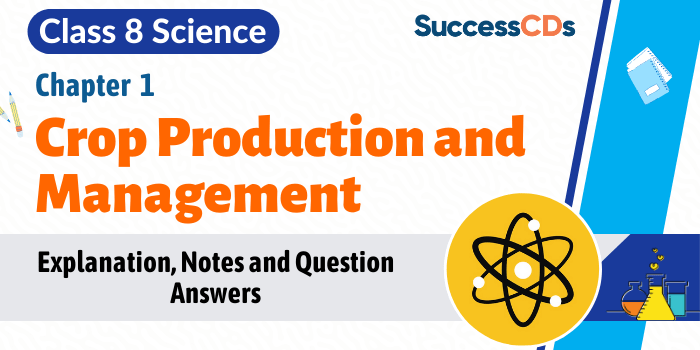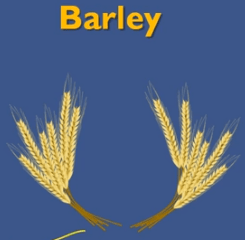Crop Production and Management Class 8 Science Chapter 1
Crop Production and Management Class 8 Science Chapter 1 as per NCERT Book used in CBSE and other Schools. The lesson covers the complete explanation of class 8 Chapter 1 Crop production and management. Topics covered are crops, types of crops, agricultural practices and implements used for farming. The difference between manures and fertilizers and types of manures have been explained. Different techniques of irrigation and ways of crop protection have been discussed elaborately. The topic of animal husbandry is also explained in detail. The lesson covers all important questions based on crop production and management. NCERT solutions to book questions have also been provided for the convenience of the students.
Chapter 1 Crop Production and Management
| What are crops? | Zaid crops | Fertilizers |
| Types of crops | Agricultural practices | methods of irrigation |
| Kharif crops | Agricultural implements | weeds |
| Rabi crops | Manures | protection of crops |
| Animal husbandry |
The topics we will cover in this chapter are:
- Basic Terminology
- Crops
- Types of crops
- Agriculture practices
- Agricultural implements
- manures and fertilizers
- Irrigation
- crop protection
- Animal husbandry
Introduction
As we know that all living organisms like green plants and animals need food for survival. The green plants prepare their own food by the process of photosynthesis while animals obtain their food directly or indirectly from plants. So, now the question comes- What about humans? Where do humans get their food from or how do they meet their daily requirements? Humans grow plants and rear animals to meet their daily requirements. But since, the human population is increasing day by day; their food requirement is also increasing along with it. Therefore, it is necessary to increase the quantity of food produced to fulfill their increasing demand. The food requirement is achieved by farming more land, increasing the food production and by managing the production and distribution of food. Thus, it is agriculture that makes possible to sustain a huge population at one time.
See Video:
What are Crops ?
Crop is a plant of the same kind that is grown on a large scale to get useful products and to meet nutritional needs in an area by man. For example, all the plants of wheat grown in a field are called wheat crop. Similarly, all the plants of rice grown in a field are called rice crop.
The plants which are grown at home or on small scale of area are not said to be crops.
Different types of Crops
There are different types of crops which are as follows:
- Cereals
- Vegetables
- Fruits
Cereals
Any grass cultivated for the edible (eatable) components of its grain is called cereal. For example: Oats, corn, rice, wheat, barley.
Vegetables
Any part of the plant which is consumed by humans as food. It covers nutritional deficiencies and gives minerals and different types of vitamins. For example: Lady finger, cabbage, peas, capsicum, cauliflower.
Fruits
Fruits are the seed bearing structures of flowering plants. For example: Banana, apple, cherry, guava, grapes, watermelon.
Basic Terminology
Let us discuss some basic terms-
Agriculture
It is a process of growing crops on a large scale.
Like, a plant which is grown in a pot at home is not said to be agriculture.
Horticulture
It is a process of growing fruits, vegetables, and ornamental plants.
Crops
The plants which are grown in large number to get useful products by men is said to be crops.
Types of Crops
There are different types of crops which are as follows:
- Kharif crops
- Rabi crops
- Zaid
Kharif crops
These are the crops grown in rainy season during the month of June to October. They are also known as summer or monsoon crop. Seeds of these crops are sown in the beginning of the monsoon season. They are harvested by September or October. For example: Maize, sugarcane, soybean, groundnut and paddy.
Rabi crops
These crops are sown in winter that is between November and December. These are known as winter crops. These crops are harvested in March or April. For example: Wheat and Barley. These crops require less water to grow.
Zaid crops
These crops are sown in summer seasons and are known as summer crops. For example: watermelon and cucumber. These crops require excessive heat to grow.

Time to check knowledge: Fill in the blanks with the correct word.
- The same kind of plants grown and cultivated on a large scale at a place is called _____________.
- The first step before growing crops is _____________ of the soil.
- Damaged seeds would _____________ on top of water.
- For growing a crop, sufficient sunlight and _____________ and _____________ from the soil are essential.
Answer:
- crop
- preparation
- float
- water and nutrients
Question: Match items in column A with those in column B.
| A | B |
| (i) Kharif crops | (a) Food for cattle |
| (ii) Rabi crops | (b) Urea and superphosphate |
| (iii) Chemical fertilizers | (c) Animal excreta, cow dung urine and plant waste |
| (iv) Organic manure | (d) Wheat, gram, pea |
| (e) Paddy and maize |
Answer:
i-e, ii- d, iii- b, iv- c
Question: Give two examples of kharif crop and rabi crop
Answer: Kharif crop includes paddy, maize, soybeans, groundnut, cotton, etc. Rabi crops include Wheat, gram, pea, mustard, etc.
Agriculture Implements
Agriculture implements are those tools that help in agriculture and they are very necessary for agriculture. For example: Plough, hoe, seed drill, and cultivator.
Let us discuss the different agricultural implements in detail-
Plough
It is made up of wood and drawn by a pair of bulls or any other animals. Ploughing is defined as loosening and turning of soil which is done by plough. It is used for tilling, adding fertilizers, removing seeds, etc.
Plough contains a strong iron strip called plough share and a long log of wood called plough shaft. There is a handle on one end and another handle is attached to a beam placed on bull’s neck. This can easily be operated by a pair of bulls or man.
Hoe
It consists of long rod of wood. A strong broad plate of iron is fixed to one of its end and works like blade.
It is also pulled by animals. It is used for removing weeds and for loosening soil.
Cultivator
When plough is attached to a tractor is called as cultivator.
It saves time and labour.
Seed drill
It is used for sowing seeds. In a seed drill, an iron tube with a funnel is placed at the top. Seeds are put in the funnel and then released in soil furrows.
It saves time and seeds are sown at the right depth. This is the efficient method for practicing agriculture.
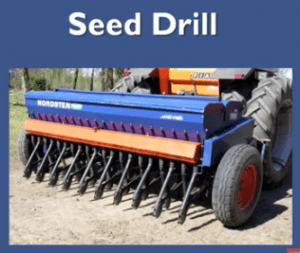
Agriculture practices
There are different practices which are used and these are as follows:
- Preparation of soil
- Sowing
- Apply manures and fertilizers
- Irrigation
- Weeding
- Protection of crops
- Harvesting, Threshing, and Winnowing
- Storage
Preparation of soil
It involves ploughing, leveling, and manuring.
Ploughing is defined as turning and loosening of soil with a plough.
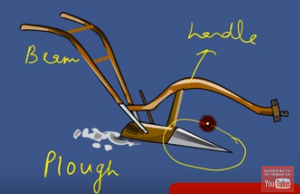
Advantages of ploughing
- It helps in the penetration of roots deeply.
- Soil gets loose by ploughing and therefore, air can pass through it. So, we can say that it aerates the root.
- It is helpful in removing unwanted plants or weeds.
- It is helpful in mixing or upturning of soil.
- It is helpful in destroying harmful organisms.
Leveling
After ploughing, certain lumps are left. Then, leveling helps in breaking of big lumps of soil. It is done by a leveler.
Advantages of leveling
- It is helpful in protection of soil from erosion.
- It promotes irrigation.
Manuring
It is defined as mixing of soil with manure. It is helpful in increasing soil fertility.
Fertility means soil has sufficient nutrients.
Sowing
It is defined as process of putting seeds in soil.
Seeds are selected on the basis of:
- High yielding variety (HYV) seed is used.
- Seeds should be germinated in nature and germinated in plant. It should not be dormant and it means the seeds which is not converted into plant.
- Seeds should be sown at right depth.
- There should be a proper distance maintained between each seed. Overcrowding should be avoided.
- Seeds should be free from diseases.
- Seeds used should be viable means it should be converted into plant.
Question: What are weeds? How can we control them?
Answer:
Weed is any plant that grows wild and forcefully, especially among cultivated plants. Weeds are unwanted plants. These unwanted plants compete with the main crop plants for nutrients and space.
Weeds can be removed by uprooting or cutting them close to the ground, from time to time. This is done with the help of a plough. Weeds can be removed by using weedicides. The process of removing the weeds from the crop field is called weeding.
Methods of sowing
There are different methods of sowing which are explained as follows:
Broad Casting
It is a method in which seeds are sown manually directly by scattering in soil. Disadvantage of this method is that it leads to unequal distribution of seeds and thereby reduces crop yield.
Seed drill
In a seed drill, an iron funnel is placed at the top. Seeds are put in the funnel and then released in soil furrows. The advantage of this method is that it saves time and seeds are sown at right depth.
Transplantation
In this method, seeds are sown first in nurseries, and then the seedlings are transferred to the main field. For example: Paddy.
Question: What is the traditional tool of sowing?
Answer: The traditional tool shape is like a funnel. The seeds are filled into the funnel which passes down through pipes having sharp ends. These sharp ends pierce into the soil and put seeds there.
Manures and Fertilizers
They both play an important role in the production of healthy growth. These are added to the soil to maintain the fertility of soil.
Fertile soil is defined as the soil which has all the nutrients required for the growth of seeds.
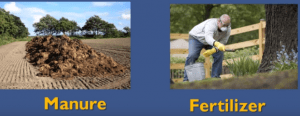
Manures
These are the organic substances obtained by the decomposition of plants and animals waste.
Types of Manures
Farm yard
It consists of cattle dung and urine.
Compost
It is formed by the decomposition of plants and animals. If decomposition can be done in the presence of earth worm, it is known as vermicompost.
If decomposition is done in the presence of bacteria, then it is known as bacterial compost.
Green manure
It consists of decomposed leguminous plants like sunhemp. Leguminous plants are the plants whose roots have special bacteria and that bacteria is helpful in nitrogen fixation.
Advantages of Manure
The advantages of manure are as follows –
- It adds nutrient to soil.
- It adds humus to soil.
- It improves the quality of soil.
Fertilizers
These are the inorganic compounds which supply specific nutrients.
For example: NPK (Nitrogen Phosphorus Potassium), ammonium sulphate, ammonium phosphate etc.
Question: What is the difference between fertilizers and manure?
Answer:
| Manure | Fertilizer |
| It is a organic substance. | It is it is an inorganic substance. |
| It provides all the essential nutrients to the soil. | It provides all the required or specific nutrients to the soil. |
| Its action is slow. | Its action is fast. |
| Manure adds humus to the soil. | It does not add humus to soil. |
| Manure is required in very large number. | It is required in small numbers. |
| Manure takes long period of time to show result. | It shows result in very less period of time. |
| Manure is difficult to store and transport. | FertiFertilizers are easy to store and transport. |
| Manure is biodegradable. | Fertilizer is non-biodegradable. |
| It is prepared in fields. | It is prepared in laboratories. |
Irrigation
It is supplying water to plants.
Sources of irrigation
Water can be obtained from pond, lake, tube well.
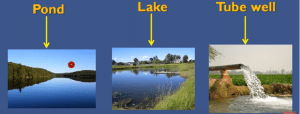
Traditional method of Irrigation
The traditional methods of irrigation are as follows-
Moat: Water is pulled out from the well and directly supplied to the plants.
Dhekli: In dhekli, buckets are used and then with the help of rope, water is pulled out from the well.
Rahat: In this method, buckets are knotted with rope on wheel and then bulls rotate the handle due to which wheel turned up and then water gets filled into the bucket and used for different purposes.
Chain pump: In this method, two wheels are used. The one wheel is easily visible and the another wheel at the bottom is slightly dipped into the soil. These two wheels are connected with each other through chain and buckets are joined with wheel. When wheels rotate buckets get filled and used for different purposes.
 |
 |
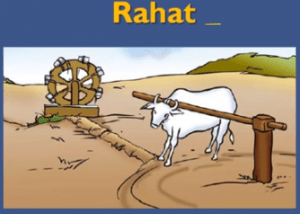 |
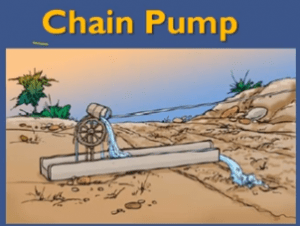 |
Modern methods of irrigation
In modern methods, two methods are used which are as follows:
Sprinkler
In this method, water is distributed through a system of perpendicular pipes usually by pumping.
It is then sprayed into the air over entire soil surface through spray heads on rotating nozzles so that it breaks up into small water drops which fall to the ground. This system provides efficient coverage for small to large areas and is suitable for use on all types of soil. This method of supplying water is similar to rainfall.
Drip system
In this system, water falls drop by drop just at the position of roots. Drip Irrigation also called trickle irrigation.
A drip irrigation system carries water directly to the base of each individual plant. Water is allowed to fall drop by drop from a pipe, just near the roots. It is an ideal watering method. It saves water. It also reduces soil erosion. Water and nutrients reach directly to the places where needed. It saves time and labour.
Uses
It is helpful in the translocation of food.
It protects the crops from frost and hot climate.
Disadvantages of excess irrigation
Due to excess irrigation seeds can’t respire.
Due to excess irrigation roots do not grow well.
Weeds
Weeds are unwanted plants that grow with the main plant. The process of removing weeds is called weeding. For example: Amaranthus, grass, wild oats.

Disadvantages of weeds
Weeds compete with main crops for nutrients, space, sunlight, water etc. Due to weeds, main crop gets affected.
Methods of weeding
Let us see methods of weeding –
Manual weeding:
It is the method in which weeding is done by hands. This process is time consuming.
 Weedicides:
Weedicides:
These are the chemicals that are used to kill weeds. For example: 2-4 D etc. In this methods we spray the chemicals.
Protection of crops
Crops are protected from pests
Pests are the organisms that damage crops. For example: Insects, bacteria etc.
Pests affect crops in various ways as follows-
- They lower the quality of crops.
- They reduce yield.
- They bore inside the crops.
Pests are removed by pesticides. Pesticides are the chemicals that kill pests. For example: DDT.BHC and Malathion etc.
Question: What would happen if wheat is sown in the kharif season? Discuss it?
Answer: Wheat is a rabi crop, grown in winter season. Hence, it requires cold climatic conditions to be grown properly. It does not require too much water for its growth. If wheat is sown in kharif season, the crop may wilt as it cannot tolerate excess water. Therefore, wheat should not be sown in the kharif season.
Question: Discuss each of the following.
(a) Preparation of soil (b) Sowing (c) Weeding (d) Threshing
Answer:
(a) Preparation of soil
For good crops, soil preparation is a very necessary step which includes ploughing and leveling. Ploughing of soil is very necessary for germination of seeds and growth of crops.
It is important because :
(a) loose soil helps roots to penetrate deep into the soil. It helps the plants to fix strongly.
(b) loose soil particles have more space that helps the roots to breathe easily.
(c) loose soil mixes with manures and fertilizers more easily.
(d) loose soil promotes the growth of useful soil microbes, which helps to add humus to the soil.
(e) loose soil can hold water for a longer period.
(f) It helps to uproot weeds from the soil easily.
Leveling is important because:
(a) In a field, small mud pieces called crumbs are left after ploughing. They should be leveled by using leveler.
(b) It prevents soil erosion and also prevents soil from being blown away easily by the wind.
(c) Levelling also helps the soil to take water easily.
Sowing
Sowing is the most important part of crop production. When the soil is ready, the farmers sow the seeds. It is the process of putting the seeds in proper depth in the soil. Good quality seeds are clean and healthy seeds of a good variety. Seeds can be sown by seed drill or manually.
Weeding
Weed is any plant that grows wild and forcefully, especially among cultivated plants. Weeds are unwanted plants. These unwanted plants compete with the main crop plants for nutrients and space. For example: Amaranthus (Chaulai), Chenopodium (Bathua) with the main crop plants. Weeds can be removed by using weedicides. The process of removing the weeds from the crop field is called weeding.
Threshing
After harvesting, threshing is done. It is the process of loosening the seeds from the husk and straw. In olden times, this was done by beating the grains with sticks or some other objects.
Harvesting
The process of cutting and gathering mature crops from the field with sickle is called harvesting.
Methods of Harvesting
The different methods of harvesting are as follows –
Threshing
It is the process of separating grain from hay.
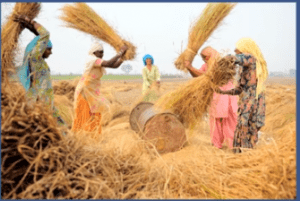
Winnowing
It is the process of separating chaff from grains.
Storage
If storage is not done in well-maintained order, our crops get destroyed.
Methods Employed for storage
Drying: Seeds can be stored by drying as by doing this, moisture gets removed and it prevents the growth of microorganisms.
Maintaining storage containers
Gunny bags, earthen pots, etc should not be used repeatedly. It should always be new, without cracks etc. By doing this, microorganisms will not grow and seeds can be saved for a longer period of time.
Chemical treatment
Godowns, etc. should be sprayed with fumigants and there should be no seepage so that crops can be stored properly. If water is present in godowns, it may lead to the formation of microorganisms and these microorganisms might spread diseases. Thus, it can harm storage.
Uses of improved storage structures
The storage structures that are airtight, rat proof, can maintain steady temperature etc should be used. For example: silos.
Advantages of storage
- Food does not get spoiled.
- It is helpful in the availability of fruits & vegetable whole year.
- It is also helpful in the maintenance of emergency stock like during flood.
Storage
Dry storage
There are certain seeds that need dry storage. For example: Food grain etc.
Cold storage
There are certain seeds that need cold temperature for its storage. For example: Fruits including apples, banana, pear etc.
Question: How fertility of soil can be maintained by natural methods?
Answer: The fertility of soil can be maintained by:
- Crop rotation
- Multiple cropping
Crop rotation
Method of growing crops alternatively on same land is known as crop rotation.
For example: Cauliflower is sown and harvested. Let us suppose cauliflower used nitrogen from soil. It means that the soil has less nitrogen and then we need to grow that crop which has high nitrogen and does not require nitrogen for its growth.
Crop rotation has a lot of benefits
- The land gets utilized in a better way.
- Soil fertility is maintained.
- Farmer has variety of crops for selling.
Example of crop rotation
Legumes include pea, beans, grams and pulses are grown in first season and wheat should be grown next to it. In roots of legumes, rhizobium (bacteria) is present and this rhizobium is helpful in fixing of atmospheric nitrogen. It means that it converted it into nitrogen compound and add it in the soil. Thus, soil will have not nitrogen deficiency. Then wheat should be sown and requires nitrogen. Then, again we can grow legumes to maintain nitrogen level in soil.
The legume crops (has nitrogen fixing bacteria) uses up different nutrients from the soil but it fixes atmospheric nitrogen and makes the soil richer in nitrogen and maintain the fertility of soil.
Multiple cropping
Method of growing two or more types of crops in same field is called multiple cropping.

Criteria of selecting crops
Crops with different maturation period are chosen. The crop which gets mature first will be harvested first and then the crop that will mature later will be harvested accordingly. For example: sugarcane, legumes.
Problems faced by farmers
- Difficulty in harvesting.
- Difficulty in supplying fertilizers.
- Can spread pest.
- Can lower the quality of crops.
For better results: Multiple cropping can be converted into intercropping.
Intercropping is defined as growing different crops in definite pattern. For example: By making rows. By this method, pest will not spread and easy to harvest.
All limitations of multiple cropping are overcome by intercropping.
Check your knowledge by answering the following questions-
Question: Why is adding green manure to soil significant?
Answer: There is a time gap between harvesting a crop and sowing of the next crop. Instead of leaving the field without any plants on it during the gap period, a fast growing leafy leguminous fodder crop such as trifolium (barseem), or alfalfa or sasbania can be sown. This crop grows soon and it yields green leafy fodder for the cattle. It bears root nodules complete with nitrogen fixing bacterium. This enriches the soil with mineral nutrients. While preparing the field for sowing the next crop, the field is ploughed along with green leguminous crop and its nodule bearing roots. The green plants along with the roots and root nodules go into the soil and decompose to form organic manure (compost). This is green manure.
Question: What is the requirement of protection of crops?
Answer: Plant protection is the science and practice of managing invertebrate pests and vertebrate pests, plant diseases, weeds and other pest organisms that damage agricultural crops and forestry. Agricultural crops include field crops (maize, wheat, rice, etc.), vegetable crops (potatoes, cabbages, etc.), fruit and horticultural crops. The crops in the field are exposed to many factors.The crop plants may be destroyed by insects, birds, rats etc. Crop protection encompasses.
The crops can be protected from weeds, pests etc. by following methods:
(i) Chemical control
(ii) Biological control
Question: What are the main purposes of storing food items?
Answer: Storing of foods has several main purposes as follows:
- Storage of harvested and processed plant and animal food products ensures distribution to consumers.
- It enables a better-balanced diet throughout the year.
- Protection from animals is also ensured. Storage is done in many ways like cold storage, dry storage.
- Storage is also done for fighting emergency conditions.
Question: Differentiate between mixed cultivation and crop rotation
Answer: In mixed cultivation, two or more different types of crops are sown in a particular field at the same time. For example, pea plants can be grown in the same field along with a cereal like wheat.
Crop rotation is a practice of growing two or more dissimilar crops in the same field one after the other. The nutrient requirements of a particular crop are kept in mind when crops are grown on a rotational basis. For example, it is a known fact that paddy uses up a lot of nitrogen from the soil. When planning for the subsequent crop to be sown, this fact is kept in mind. So leguminous plants like soya bean or pea are purposely sown so that this loss of nitrogen can be replaced naturally by them.
Animal husbandry
It is the process of breeding, feeding & caring of livestock for food & other useful purposes.
Different categories of animals
Milch Animals: These are the animals which gives milk. For example: Cow, buffalo, and goat.
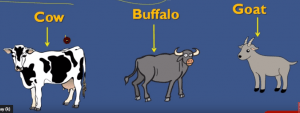
Meat and egg giving animals:
These are the animals which gives egg and meat. For example: Pig, cattle, and hen.
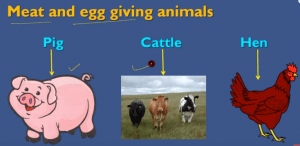
Draught animals (Working animals)
- Buffalo
- Camel
- Horse
Needs of Animal Husbandry
As animals are serving various purposes, so there is a need to take care of them. This will help us improve livestock and extract maximum use from them. Moreover their dung, urine, etc is also used as manure (used to maintain fertility of soil).
Nitrogen Cycle
It is the process by which nitrogen is converted to its various chemical forms. This transformation can be carried out through both biological and physical processes. Important processes in the nitrogen cycle include–
- Nitrogen Fixation: The conversion of nitrogen into nitrates is known as nitrogen fixation.
- Nitrate Assimilation: Plants absorb nitrates from the soil through their root system and convert them into plant proteins. When animals eat these plants, the plant proteins are converted into animal proteins.
- Ammonification: The process of conversion of plant and animal proteins into ammonium compounds by putrefying bacteria in soil is called ammonification.
- Nitrification: The ammonium salts are converted into nitrites by Nitrosomonas bacteria. The nitrites are then converted into nitrates by Nitro bacteria. This process is called nitrification.
- Dentrification: The conversion of nitrates into free nitrogen gas by denitrifying bacteria (Pseudomonas bacteria) is called denitrification.
Question & Answers
Question: State whether the following statements are true or false
- Rice is transplanted in standing water. True
- Crop rotation gives various nutrients to the soil. True
- Storage of grain is harmful to us. False
Question: Write advantages of manure
Answer: The advantages of manure are:
- It enhances the water holding capacity of soil.
- It make soil porous due to which exchange of gases becomes easy.
- It improves the texture of soil.
- It does not create any pollution in soil.
- It provides all the nutrients.
Question: How grains are stored and preserved?
Answer: Farmers store grains in jute bags. However, large scale storage of grains is done in silos and granaries to protect them from pests like rat and insects. Dried neem leaves are also used in storing food grains at home for storing large quantities in big godowns and specific chemical treatments are required to protect them pests and microorganisms.
Question: What is hoe? What is its use?
Answer: Hoe is a simple tool which is used for removing weeds and for loosening the soil. It has a long rod of wood or the iron. A strong broad and bent plate of iron fixed to one of its ends and works like a blade. It is also pulled by animals.
Question: Explain harmful effects of pesticides
Answer: The excessive use of pesticides has made the soil less fertile. They have also become a source of pollution. They do not help in maintaining soil fertility.
Crop production and management – CBSE book solutions
- The process of loosening and turning the soil is called
(a) Broadcasting
(b) Irrigation
(c) Ploughing
(d) Levelling
- The organic substance obtained from dead plants and animal wastes is
(a) Manure
(b) Fertilizer
(c) Irrigation
(d) Agriculture
- In which of the following methods of irrigation rotating nozzles are used?
(a) Moat
(b) Drip system
(c) Chain Pump
(d) Sprinkler system
- The management and care of farm animals by humans for profit is known as
(a) Granary
(b) Animal Husbandry
(c) Poultry farm
(d) Warehouse
- The process of separating grain from chaff is called
(a) Threshing
(b) Weeding
(c) Sowing
(d) Winnowing
- Weeds can be removed by using.
(a) Pesticides
(b) Fungicides
(c) Weedicides
(d) Bactericides
- The conversion of nitrogen into nitrates is known as
(a) Nitrogen fixation
(b) Ammonification
(c) Nitrate Assimilation
(d) Nitrogen cycle
- Animals like horse, donkey that carries load are called
(a) Drought species
(b) Load carrying Animals
(c) Dairy Animals
(d) Draught Animal
- Raising of fish in inland waters and coastal waters are called
(a) Pisciculture
(b) Fishery
(c) fish culture
(d) harvesting
Answers
- (c) Ploughing
- (a) Manure
- (d) Sprinkler system
- (b) Animal Husbandry
- (a) Threshing
- (c) Weedicides
- (a) Nitrogen fixation
- (b) Load carrying Animals
- (a) Pisciculture
Question
- In India, the two main crops according to seasons are______ and _________
- Paddy is a_________ crop.
- ________ soil helps roots to penetrate into the soil.
- A_________ is a man-made chemical substance which supplies specific nutrients to the soil.
- The process of cutting and gathering mature crops is called_______
- The ploughed field may have large pieces of mud called________
- _________ soil needs less frequent irrigation due to its good water retaining capacity.
- 8.________ are unwanted plants that grow with the main crop plants for space and nutrients.
- The ammonium salts are converted into_________ by Nitrosomonas bacteria.
Answers:
- rabi, kharif
- kharif
- ploughing
- fertilizer
- winnowing
- crumbs
- clayey
- weeds
- nitrites
Question: Match the columns:
| (a) Coffee, rubber | (i) Organic substance |
| (b) Manure | (ii) Oil crops |
| (c) Maize, cotton | (iii) Insecticides |
| (d) Coconut, mustard | (iv) Cash crops |
| (e) Malathion, DDT | (v) Rabi crops |
Answers:
a-iv
b- i
c- v
d- ii
e- iii
Question: Write a brief note on ‘Animal Husbandry’.
Answer: Animal husbandry is the management and care of farm animals by humans for profit. In animal husbandry, genetic qualities and behavior are considered to be advantageous to humans for further development. Animal husbandry has been practiced for thousands of years since the first domestication of animals. Humans are dependent on animals in innumerable ways. The animals are domesticated by humans for many purposes. Depending on the usefulness of domestic animals they are categorized as:
Meat and Egg yielding animals like pig, sheep, fish, poultry, goat and duck.
Milk-yielding animals or dairy animals like cow, buffalo and goat.
Wool and skin yielding animals like sheep, goat, camel, buffaloes and cow. Skins are used as leather for different articles.
Question: Differentiate between sprinkler and drip irrigation.
Answer:
Sprinkler: Sprinkler system is composed of pipelines in which nozzles are fitted at various locations. Water comes out of the nozzle and is sprinkled on plants. This system helps in saving a lot of water.
Drip Irrigation: For this, small holes are made in pipes which are laid along the rows of crops. Water slowly drips down on the roots of crops. This system is especially useful for plantations and also in water scarce areas.
Question: What are silos? What measures are taken to keep silos free from rodent infestation?
Answer: Silos is a large-scale storage facility for grains to protect them from pests and rats.
1. Place the silo in a covered area and on a pallet to avoid contact with moisture. Ensure it is away from direct heat and sunlight.
2. Dry clean grain to less than 13% moisture for cereals and less than 10% for pulses and oilseeds.
3. Clean and dry the inside of the silo.
4. Insert a burning candle in the silo to use up all oxygen to ensure all pests die. Do not open the silo for 30 days to ensure all living organisms die.
